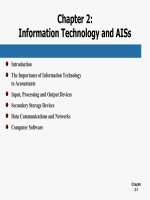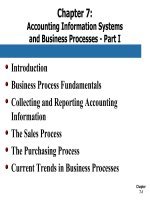Accounting information systems 12th SIMKIN and norman chapter 01
Bạn đang xem bản rút gọn của tài liệu. Xem và tải ngay bản đầy đủ của tài liệu tại đây (343.58 KB, 47 trang )
Chapter 1:
Accounting Information Systems
and the Accountant
Introduction
What Are Accounting Information Systems
(AIS)?
What’s New in AIS?
Accounting and IT
Careers in AIS
Chapter
1-1
Introduction
Applying information technology (IT) to accounting
systems
Financial accounting
Managerial accounting
Auditing
Taxation
Increased career opportunities
Specialized employment
Combine accounting and advanced computer skills
Chapter
1-2
Accounting Information Systems
An Accounting Information System (AIS)
Data and processing procedures
Creates needed information for users
AIS Today
Financial and non-financial data
Enterprise-wide information system
Business process focused
Chapter
1-3
The Accountant’s Challenge
Provide information to support decision-making
Business and Government processes
Accounting and Finance
Non-Accountants
Chapter
1-4
Information (versus Data)
Data
Raw facts
No organization or meaning
Beginning of audit trail
Information
Processed data
Meaningful to users
Chapter
1-5
AIS Components
Chapter
1-6
Computerized Data
Processing Problems
Information overload for users
Unable to identify input errors
Difficult to follow audit trails
Chapter
1-7
AIS and ERP
Accounting Information Systems
Internal and External users
Financial information
Enterprise Resource Planning Systems
Internal users
Financial and Nonfinancial information
Predictive analytics
Chapter
1-8
AIS and ERP
Overlapping of the Systems
Provide same information
Emphasize business processes
Integration into seamless databases
Chapter
1-9
Study Break #1
Which of the following is likely to be information rather than
data?
A. Sales price
B. Customer number
C. Net profit
D. Employee name
Chapter
1-10
Study Break #1 - Answer
Which of the following is likely to be information rather than
data?
A. Sales price
B. Customer number
C. Net profit
D. Employee name
Chapter
1-11
Study Break #2
With respect to computerized AIS, computers:
A. Turn data into information in all cases
B. Make audit trails easier to follow
C. Cannot catch mistakes as well as humans
D. Do not generally process information more quickly than
humans
Chapter
1-12
Study Break #2 - Answer
With respect to computerized AIS, computers:
A. Turn data into information in all cases
B. Make audit trails easier to follow
C. Cannot catch mistakes as well as humans
D. Do not generally process information more quickly than
humans
Chapter
1-13
AIS: Role in Organizations
Information Age
Impact of technology
Fewer workers producing goods
Knowledge workers
Produce, analyze, manipulate, and distribute information
Focus on business activities
Chapter
1-14
AIS: Role in Organizations
E-Business
Conducting business over the Internet
Increased importance and growth
E-Commerce
Subset of e-business
Buying and selling transactions
Chapter
1-15
What’s New in AIS?
Cloud Computing
Sustainability Reporting
Suspicious Activity Reporting
Forensic Accounting, Governmental
Accountants, and Terrorism
Corporate Scandals and Accounting
Chapter
1-16
Cloud Computing
Chapter
1-17
Disadvantages of Cloud
Computing
Reliability of Internet Connection
Data Security Measures of Provider
Quality of Service
Reliability of Service Provider
Chapter
1-18
Sustainability Reporting
Reporting Nonfinancial Measures
Impacts on income, value, or future performance
Chapter
1-19
Suspicious Activity Reporting
Chapter
1-20
Forensic Accounting
Forensic Accounting
Combines skills of investigation, accounting, and auditing
Provides evidence of criminal activity
Examples of AIS Uses in Forensic Accounting
Identifying and denying financial aid to terrorists
Tracing arms and chemical orders to final destination
Planning for catastrophic events
Controlling cyber terrorism
Detecting money laundering and illegal transfers
Chapter
1-21
Corporate Scandals and
Accounting
Enron (2001)
Manipulation of accounting records
Understate liabilities and inflate earnings
Bernard Madoff (2008)
Investment fund manager
Ponzi scheme
Resulted in billions of dollars in losses
Chapter
1-22
Study Break #3
The Sarbanes-Oxley Act of 2002:
A. Enables U.S. officers to wire tap corporate phones if
required
B. Has led to a decrease in the amount of work done by
auditors and accountants
C. Forbids corporations from making personal loans to
executives
D. Requires the CEO of a public company to take
responsibility for the reliability of its financial statementsChapter
1-23
Study Break #3 - Answer
The Sarbanes-Oxley Act of 2002:
A. Enables U.S. officers to wire tap corporate phones if
required
B. Has lead to a decrease in the amount of work done by
auditors and accountants
C. Forbids corporations from making personal loans to
executives
D. Requires the CEO of a public company to take
responsibility for the reliability of its financial statementsChapter
1-24
Study Break #4
The acronym SAR stands for:
A. Simple accounting receipts
B. Suspicious accounting revenue
C. Suspicious activity reporting
D. Standard accounts receivable
Chapter
1-25









